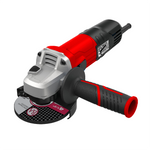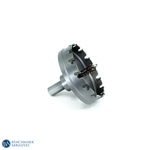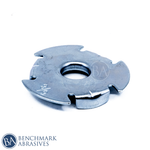
How Often Should Grinding Machines Be Inspected For Safety Compliance

Grinding machines are powerful tools essential for removing material and finishing across different sectors. However, their inbuilt mechanics, which include high-speed rotating abrasive wheels, can lead to severe accidents or safety hazards if not maintained and operated properly. To overcome these hazards while maintaining a safe working environment, frequent and thorough assessments of grinding machines for safety purposes are extremely essential.
This article will cover all the necessary questions of how often grinding machines should be inspected for safety compliance. There are several criteria to determine how frequently these assessments should be conducted, as there is no such solution as one-size-fits-all.
We will examine different contributing factors like frequency of use, the type of machine, work environment, manufacturer recommendations and outcomes of risk assessment.
General Guidelines For Inspecting Grinding Machines
How frequently grinding machines are inspected for safety compliance is based on factors like the type of machine, its applications, and applicable laws and standards. below are the general guidelines that can be applicable in the case of using a grinding machine.
1. Regulatory And Standards Guidelines
The following are the key factors to be considered while inspecting grinding machines for safety compliance:
OSHA (Occupational Safety and Health Administration)
The Occupational Safety and Health Administration is a US-based government organization that ensures worker safety, especially concerning grinding machines. OSHA's regulation strategy places a strong emphasis on employer accountability, mandating that companies proactively identify and reduce risks. OSHA mandates compliance with certain safety standards, but it does not specify a universal inspection frequency for all grinding machine parts. Rules and regulations set by OSHA are essential, particularly 29 CFR 1910.215 abrasive wheels. Below are the required outlines for the safe use of grinding wheels:
- Construction and guard design
- Wheel mounting techniques
- The need for 'ring testing' abrasive wheels prior to fitting. this helps in finding cracks.
Furthermore, grinding machines are subject to general machine guarding regulations, which highlight the necessity of strong protection measures and are outlined in 29 CFR 1910.212.
Apart from safety compliance, OSHA also focuses on avoiding injuries by encouraging appropriate guarding, making sure that the grinding wheels run within their authorized speed, and enforcing to use of appropriate personal protective equipment (PPE).
Although OSHA fails to provide the exact frequency of inspections for every machine part, it mandates that machines are maintained in a safe operating condition, which results in routine inspections decided by employer-conducted risk assessments.
OSHA enforces these regulations and standards by conducting inspections and issuing tickets and penalties for any breaches highlighting the significance of an all-encompassing safety policy that poses a high value on hazard prevention and compliance.
ANSI B7.1 (American National Standard Safety Code for the Use, Care, and Protection of Abrasive Wheels).
This standard covers all the guidelines for the proper and safe use of grinding wheels and also includes suggestions for handling, inspection, storage, and general machine conditions. It shows the importance of checking grinding wheels on a regular basis for any damage before installing the wheel. Yet, it doesn’t specify the frequency of assessment for the entire machine.
2. General Guidelines
Before Each Use: a brief visual evaluation by the operator must be done before each use. This process involves the evaluation of the grinding wheel for cracks or damage, making sure that the guards are in the right place and working condition, and ensuring that the workpiece is securely clamped.
Daily: This includes a thorough daily evaluation like cleaning the machine, inspecting for loose parts, checking belts and spindles for any damage, and ensuring the machine is well-lubricated.
Monthly: monthly inspections are mostly carried out by the safety or maintenance department. This process involves a more thorough evaluation of all safety features, electrical connections, and the machine's general condition. Several companies conduct these monthly checks by using a checklist.
Semi-Annually To Annually: the semi-annually or annually routine professional inspections must be conducted by certified technicians. This includes alignment checks, calibration, identifying the signs of early wear on major parts, and making sure that the machine is working within safety limits.
Important Elements To Examine Frequently
Following is the list of essential elements to check regularly:
- Grinding Wheel: Look for any cracks. wear, chips, proper installation, and verify that the RPM rating aligns with the machine. also, it is essential to run a ring testing before mounting
- Guards: make sure that all the necessary guards are installed, are of the right type, are securely attached, and are in good working order.
- Work Rest: the work rest for bench and pedestal grinders needs to be securely fastened and rightly adjusted within 1/8 inch of the wheel.
- Electrical Connections: check for safe and undamaged wiring, correct grounding, and right plugs.
- Emergency Stop: Confirm that the emergency stop feature is operational and readily available.
- Lubrication: always make sure that the moving parts are well-lubricated as per the manufacturer’s manual.
- Coolant System: ensure to check the coolant system, including coolant levels and quality, and make sure that there are no blockages in the system.
- Ventilation/Dust Collection: if applicable, make sure that the dust collectors or air filters are in good working condition.
In accordance with pertinent safety standards and regulations, such as OSHA and ANSI B7.1, the precise frequency should be decided by conducting a risk assessment of your activities, taking into account the manufacturer's recommendations, the degree of use, and any possible risks.



































































